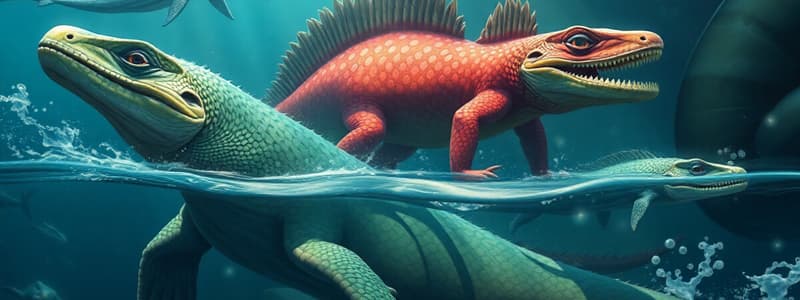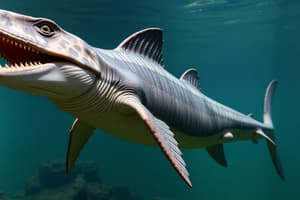Podcast
Questions and Answers
Which marine reptiles can remain submerged for multiple hours?
Which marine reptiles can remain submerged for multiple hours?
- Marine Iguanas
- Sea turtles
- Sea snakes (correct)
- Saltwater crocodiles
What is a characteristic of ovoviviparous sea snakes?
What is a characteristic of ovoviviparous sea snakes?
- Giving live birth to young (correct)
- Hatching from eggs in the water
- Producing eggs with hard shells
- Laying eggs in nests on the beach
Which of the following is a fully marine mammal group?
Which of the following is a fully marine mammal group?
- Early Eocene mammals
- Desmostylians (correct)
- Semi-aquatic pinnipeds
- Oligocene mammals
During which two time periods did the main groups of marine mammals evolve?
During which two time periods did the main groups of marine mammals evolve?
What is the dietary habit of sirenians?
What is the dietary habit of sirenians?
Which extant animal group is the sister group to cetaceans?
Which extant animal group is the sister group to cetaceans?
What adaptation do mysticeti use to filter plankton?
What adaptation do mysticeti use to filter plankton?
What is the name of the heaviest vertebrate to have ever lived?
What is the name of the heaviest vertebrate to have ever lived?
What is the study of dating strata/rock layers by fossil contents called?
What is the study of dating strata/rock layers by fossil contents called?
What feature do tunicates possess as larvae?
What feature do tunicates possess as larvae?
Which structure in tunicate larvae detects light direction?
Which structure in tunicate larvae detects light direction?
What is the function of the notochord?
What is the function of the notochord?
When did the first chordates appear?
When did the first chordates appear?
What is the general characteristics of agnathans?
What is the general characteristics of agnathans?
What type of skeleton did ostracoderms have?
What type of skeleton did ostracoderms have?
What is the primary component of bone in osteichthyes?
What is the primary component of bone in osteichthyes?
Which of these groups has limb buds supporting fins connected to the skeleton by a single bone?
Which of these groups has limb buds supporting fins connected to the skeleton by a single bone?
What adaptation helped early tetrapods transition to land?
What adaptation helped early tetrapods transition to land?
During which period did tetrapods move into marine environments?
During which period did tetrapods move into marine environments?
What type of diet did some marine reptiles have?
What type of diet did some marine reptiles have?
Flashcards
Modern Marine Reptiles
Modern Marine Reptiles
Reptiles mostly living in the ocean, including sea turtles, marine iguanas, saltwater crocodiles, penguins, and puffins.
Fully Marine Sea Snakes
Fully Marine Sea Snakes
Only sea snakes are fully marine and give live birth. They can remain submerged for multiple hours.
Fully Marine Mammals
Fully Marine Mammals
Marine mammals, including whales, dolphins, porpoises, and sirenians (dugongs and manatees).
Desmostylians
Desmostylians
Signup and view all the flashcards
Sirenians
Sirenians
Signup and view all the flashcards
Cetaceans and Artiodactyls
Cetaceans and Artiodactyls
Signup and view all the flashcards
Odontoceti
Odontoceti
Signup and view all the flashcards
Mysticeti
Mysticeti
Signup and view all the flashcards
Perucetus colossus
Perucetus colossus
Signup and view all the flashcards
Biostratigraphy
Biostratigraphy
Signup and view all the flashcards
Biochronology
Biochronology
Signup and view all the flashcards
Chordate Larvae
Chordate Larvae
Signup and view all the flashcards
Somiticordata
Somiticordata
Signup and view all the flashcards
Agnathans
Agnathans
Signup and view all the flashcards
Ostracoderms
Ostracoderms
Signup and view all the flashcards
Placoderms
Placoderms
Signup and view all the flashcards
Chondrichthyes
Chondrichthyes
Signup and view all the flashcards
Osteichthyes
Osteichthyes
Signup and view all the flashcards
Actinopterygii
Actinopterygii
Signup and view all the flashcards
Sarcopterygii
Sarcopterygii
Signup and view all the flashcards
Study Notes
-
Many semi/mostly marine reptiles exist, such as sea turtles, marine iguanas, saltwater crocodiles, penguins, and puffins
-
Sea snakes are fully marine reptiles
- Sea snakes are ovoviviparous, meaning they have live births
- Sea snakes can remain submerged for multiple hours
-
Marine mammals include cetaceans (whales, dolphins, porpoises) and sirenians (dugongs and manatees)
- Desmostylians are an extinct, fully aquatic group of marine mammals
-
Two time periods saw the evolution of main groups marine mammals
- Cetaceans and sirenians appeared in the early Eocene
- Desmostylians and cetaceans diversified, and semi-aquatic pinnipeds appeared in the Oligocene
-
Desmostylians are aquatic herbivores
- Desmostylians lived in the Oligocene-Miocene (~30-7 MA)
- Desmostylians are now thought to be fully marine
- Proboscidea (elephants) is the sister group to desmostylians
- Tethytheria includes sirenians + elephants + desmostylians
-
Sirenians are herbivorous, eating seagrass in warm, shallow, marine to brackish areas
- Proboscidea (elephants) and desmostylians are sister group to sirenians
- Dugongs (1 species) and manatees (3 species) make up sirenians
-
Cetaceans are artiodactyls (even-toed ungulates) like cows, pigs, deer, giraffes, and camels
- Cetaceans appeared in the early Eocene - present
- Hippopotamus is the sister group to cetaceans
- Cetaceans split into two clades in the Oligocene
- Odontoceti (toothed whales) are active predators of fish, squid, and mammals using echolocation
- Mysticeti (baleen whales) use baleen plates to filter plankton from water
-
Perucetus colossus is the heaviest vertebrate that ever lived
- Perucetus colossus lived in middle Eocene Peru
- Perucetus colossus is only known from vertebrae and is not the heaviest vertebrate ever
-
Biostratigraphy dates strata/rock layers by fossil contents
-
Biochronology dates biological events/time periods using fossil groups not tied to rock layers
- This may vary from place to place
Studying That Suits You
Use AI to generate personalized quizzes and flashcards to suit your learning preferences.





